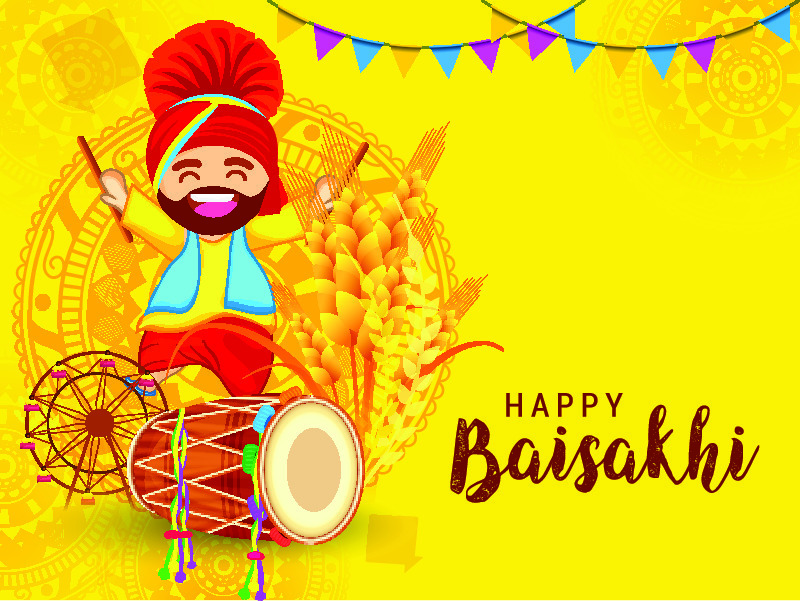Baisakhi 2023, Welcoming the Sikh New Year and Celebrating Crop Harvests
India houses a rich, diverse culture, and the new year celebrations of all ethnic communities are observed with much fun and zeal. Baisakhi (also referred to as Vaisakhi) marks the first day of the Sikh new year and is celebrated with warmth and joy all across the globe. It is celebrated on the 13th of April or the 14th of April as per the English calendar. Celebrating a bountiful harvest of crops is the essence of this festival. Hence, all people of the northwest region of India, mostly the Punjab region, celebrate Vaisakhi irrespective of their faith and culture.
The celebrations of Baisakhi are mesmerising as the streets of the Punjab region brighten up with colours and joy. Nevertheless, be it in India or any other part of the world, kids are the soul of the Vaisakhi celebrations. So here are five fun ways to celebrate Vaisakhi with kids and unfold the significant history entailing this festival to the precious little ones.

A Visit to the Gurdwara
The beautifully decorated Golden Temple in Amritsar is a magnificent sight on Vaisakhi. All gurdwaras are decked up with lights and decorations on this day. Hence, to start off the day, take your kids on a visit to the nearest Gurdwara. Most people visit their local Gurdwaras on Vaisakhi to begin the festivities with a morning prayer. Kids are quite fond of visiting Gurdwaras. Be it queuing up for the Kadha Parshad again, right after gulping in a steaming lump of the same, or be it offering the simple religious services, kids are mostly happy at Gurdwaras. So a visit to the gurdwaras on Vaisakhi will set the right tone for introducing the religious significance of this festival to your kids.
Introducing the Story of Panj Piaras
While kids bask in the colours of festivities and frolic on Vaisakhi, they should also imbibe the significance of this festival. This day brings a good opportunity to celebrate the roots of Sikhism and reiterate the story of the Panj Piaras. Guru Gobind Singh laid the foundation of Khalsa on Vaisakhi in 1699. The story tells us that during the celebrations, the great Guru Gobind Singh came out of his tent with a sword and asked if any Sikh would readily sacrifice his life for his faith. Five brave men stepped forward and went into the tent. They came out wearing turbans, unharmed, from the tent. They were the members of the Khalsa as they were baptised by the great Guru. Even today, in many places, five Khalsa lead the processions on Vaisakhi.
Nagar Kirtans or Street Parades
People wear colourful new clothes and parade through the streets on Vaisakhi. The special processions in which people sing out the holy hymns from Guru Granth Sahib are called Nagar Kirtans. The term ‘nagar’ stands for a town, while ‘kirtan’ refers to the hymns chanted in the procession. Often, to symbolise the Khalsa brotherhood, five men dress up as the Panj Piaras or the ‘beloved fire’ and carry the holy book of Guru Granth Sahib on a palanquin. Kids can be encouraged to watch and participate in the Nagar Kirtans on Vaisakhi so that they develop a strong sense of belonging to the roots of this festival.
Folk Dances
Coming to the most fun part of the celebrations of Vaisakhi- the folk dances, Gidda, and Bhangra. People from all castes and creeds are welcome to participate in the folk dances as a part of the Vaisakhi celebrations. The joy and anticipation of the new year are expressed through the cheerful dance moves by the farmers and locals of the Punjab region when they celebrate the festival of Vaisakhi. The rhythmic beats of dhols and the hearty folk dances engender a connection among people of and beyond the Sikh and Punjabi communities.
Participating in Langars
There is an old saying that no soul goes to sleep with an empty stomach in the land of Punjab. The people of this region often offer free food in langars as a tradition on Vaisakhi. The rich and the poor, irrespective of every social binding, are observed to share meals together in the langar. Kids are always a special part of this tradition. On Vaisakhi, allowing our kids to take part in langars and offer free food is highly impactful. It helps to inculcate the right moral values among the children, and a sense of equality reverberates in them.
Apart from the fun and frolicky celebrations, there is one important fact that kids must be aware of when they celebrate Vaisakhi. 13th of April 1919 marked a day of great loss and mourning for our country. One of the most brutal attacks was ordered by General Dyer on hundreds of innocent people attending a Vaisakhi fair at Jallianwala Bagh, Amritsar, in Punjab. Today, this place houses a gallery, a museum, and memorials of the martyrs who sacrificed their lives for our country.
Kids can be taken to the Jallianwala Bagh Martyrs’ Memorial on Vaisakhi to witness the ‘eternal flame’ lit in the honour of the martyrs. As they embark on a bright new year, the bullet-riddled wall of Jalianwala Bagh will give them a slight idea of the past that India has overcome. This will impart a different aspect of Vaisakhi to kids.
Bonfires, community fairs, and wrestling bouts also mark the festivities of Vaisakhi in some areas. Be it a remote village in Punjab or be it the streets of Vancouver, kids enjoy being a part of the celebrations of this harvest festival no matter wherever they are. The fun ways of celebrating this festival with kids enumerated above are meant to solely instil the true essence of peace, love, and harmony that Vaisakhi signifies. So, let’s ring in this Baisakhi with our kids and let the waves of joy ripple through each day of the coming year.







